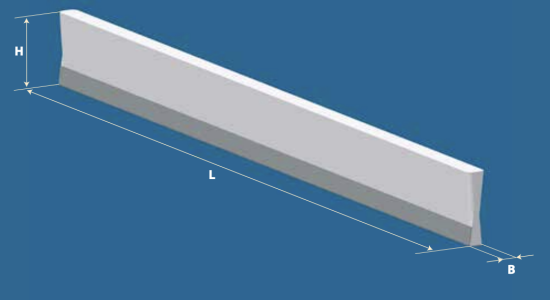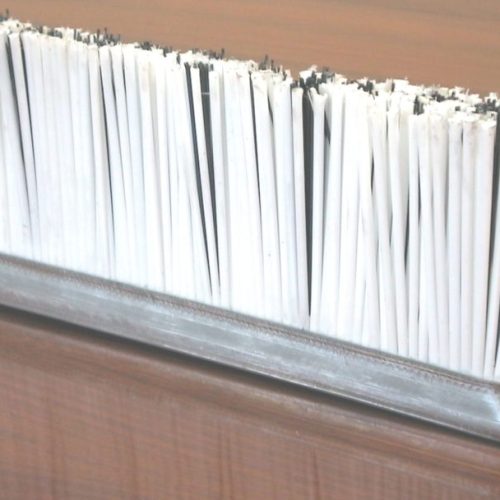Linear strip brushes
Linear strip brushes
Generalities
Linear strip brushes are used for:
- blocker
- accident prevention barrier in machine tools
- barrier for swarf, dust, vapours
- racle
- scraping of surfaces
- soundproofing of moving machine parts
Linear strip brushes have variable base thickness B as shown in the table. The length L is unrestricted, as the brushes are continuously produced from strip. For the total height H, the limitations given in the table apply.
Linear strips with double tape are not produced.

Linear strip dimensions (mm)
| B | 4 | 5 | 6 | 8 | 10 | 13 | 14 | 17 | 20 |
|---|---|---|---|---|---|---|---|---|---|
| H MAX | 100 | 150 | 150 | 200 | 200 | 400 | 400 | 400 | 400 |
Two types of profile are available for the installation of the linear brush, which is made of sturdy galvanised iron sheet. Type (a) must be welded to the metal support, while the type (b) must be mounted with screws. The available dimensions are shown in the table. The standard length is 1000 mm.
Materials:
- A: aluminium
- AN: black anodised aluminium
- S: galvanised steel
- X: inox

Dimensions Guide type (a)
| B | 8 | 10 | 13 | 14 | 20 |
|---|---|---|---|---|---|
| BS | 13 | 14 | 19 | 19 | 24 |
| TS | 12 | 12 | 15 | 15 | 27 |
| MAT. | S-X | S-X | S-X | S-X | S |
Dimensions Guide type (b)
| B | 4 | 5 | 8 | 10 | 13 | 14 |
|---|---|---|---|---|---|---|
| BS | 6.5 | 7.1 | 13 | 14 | 19 | 19 |
| TS | 6.5 | 8.8 | 12 | 12 | 17 | 17 |
| HS | 17.5 | 22.3 | 30 | 32 | 40 | 40 |
| MAT. | A-AN | A-AN | A-X | S-X | S | S |
Linear strips can also be used to reduce noise in machines that have moving parts and therefore cannot be shielded with rigid elements.
In order to find out the degree of acoustic insulation of the strip brushes, we constructed a special test apparatus, where the noise source was a compressed air nozzle. The results are shown in the Table, where R is the degree of sound insulation expressed in dB(A).
It can be seen that sound insulation is highest with smooth filaments and lowest with wavy filaments, regardless of the material. These results can only be achieved by carefully installing the brushes and making sure that there is contact between brush and surface.
Linear strip sound insulation [dB(A)]
| FILAMENTI | R |
|---|---|
| PA 66 0.30 liscio | 8.2 |
| PA 66 0.50 liscio | 7.1 |
| PA 66 1.0 liscio | 5.7 |
| Piattina Acciaio 1.1x0.25 | 5.1 |
| PA 66 0.30 ondulato | 1.5 |
| Ottone 0.30 ondulato | 1.2 |
| Acciaio AR 0.30 ondulato | 0.7 |
| Acciaio AR 0.50 ondulato | 0.7 |
Videos and images
GALLERY
Do you want to request an offer?
Are you interested in receiving more information and being contacted by one of our specialized operators?
Request your offer now

Do you want to request an offer?
Are you interested in receiving more information and being contacted by one of our specialized operators?
Request your offer now
Frequently asked questions
What is the advantage of using a brush instead of another deformable object?
The special feature of the brush is that the working surface consists of millions of individual elements, which are the ends of individual filaments.
This gives the brush an adaptability that no other element, however deformable, can have.
How much must the brush interfere with the workpiece?
It depends on various factors. In a nutshell, it can be said that 2 mm is a good compromise. The important thing is that the brush filaments work ‘on the tip’ and not on the side.
Can a bundle of filament be detached from the brush body?
Depending on the materials used and the dimensions, there is a limiting tensile load that an individual bundle can withstand.
Beyond this limit, the bundle comes off, so the brush must be calculated according to use. This limit can be greatly increased by constructing ‘sewn’ or ‘tied’ brushes by hand, where instead of a single anchoring element, a continuous steel wire is placed.
Is a punched brush or a strip cheaper?
There is no single answer. Speaking of e.g. cylindrical brushes, the strip brush is generally cheaper when the dimensions are large (e.g. over one metre in length). For small dimensions, punched brushes are certainly more suitable and convenient.
Is it possible for a single filament to slip out of the bundle and contaminate the product?
This can only happen if the brush has a manufacturing defect, like any other type of object (e.g. a roller made of silicone flakes, one of which is defective and breaks).
When it is important that no contamination occurs, synthetic (not natural) fibres with a diameter greater than or equal to 0.15 mm should be used.
What softness or hardness of brush can I achieve?
Practically all degrees of hardness are possible, from very soft to very hard. In fact, hardness is a combination of the filament diameter, its free length and the density of the bundles.
Is it possible to have a certified 'food grade' brush?
Of course, we can provide FDA or FOOD GRADE certification and filament traceability.
Is it possible to have an ATEX-certified brush?
Unfortunately not, as it is the machine + brush assembly that needs to be ATEX certified, not the brush alone.
However, it is possible to supply the materials that the certifier requires, e.g. conductive bases, conductive filaments, etc.
Is it possible to 'regenerate' a worn-out brush?
Generally speaking, it is possible, but one has to assess whether it is cost-effective, which is not always the case. In addition, in the case of a punched brush, it is inadvisable to regenerate the brush more than twice, so as not to reduce the tightness of the bundles.






